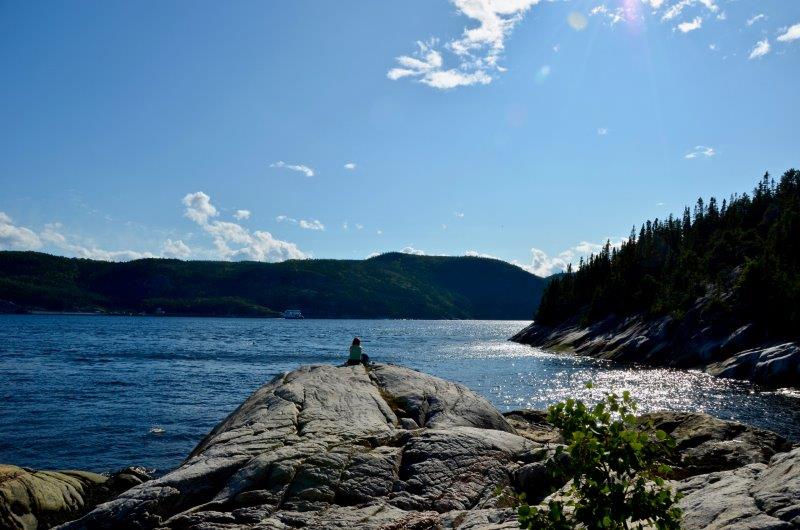
On a beautiful day, people gather on the rocks at the Saguenay St-Laurent Marine Park in Tadoussac, Quebec looking to spot a whale. Photo: Nancy Truman
The first time I picked wild blueberries was with my grandmother at a cottage on Lake Nipissing, which became the filling for wonderful little tarts. Since then, I’ve always bought at least one quart of these tiny, dark blue gems every August. But getting to pick and eat them in Lac St-Jean, Quebec was pure bliss. Gorging on these delicious treats, however, isn’t the sole reason to visit Saguenay Lac-St-Jean in late summer. It’s also a perfect time to get out and hike woodland trails, take a cruise on the Saguenay River, spot wildlife and enjoy local fare and brews outdoors. With Canadians looking to travel closer to home for the next while, Saguenay Lac-St-Jean seems a perfect place to practice social distancing. Here are a few suggestions to start planning a family getaway:
Cruising the Fjord
At the heart of the region is the Saguenay Fjord — a 100-kilometre long cut created by a glacier and fed by freshwater flowing mainly from Lac Saint-Jean and saltwater from the St. Lawrence River. Seals, whales, wolves, black bears, lynx, beaver, moose and nesting Peregrine falcons are inhabitants here, and with the right timing and luck, you might just see some of them. One of the best places to observe wildlife is in The Saguenay-Fjord National Park, a 326 sq.-km nature reserve along the banks of the Saguenay where you can hike, kayak, and try out via ferrata climbing. Head to the Discovery and Visitors Centre at Zone 3 Baie-Éternité to start the hike to the towering Notre-Dame-du-Saguenay statue atop Cap Éternité or sign up for kayaking or climbing. This is also where you can catch the Fjord Saguenay II open-deck marine shuttle to L’Anse-Saint-Jean to enjoy a leisurely lunch. L’Anse-Saint-Jean — a member of the Association of Quebec’s most beautiful villages — is known for its well-preserved heritage homes, historic church and covered bridge. The park fee for hikers 18 years and older is $8.75 and includes parking. Family rates are available for cruises and sea kayak excursions.
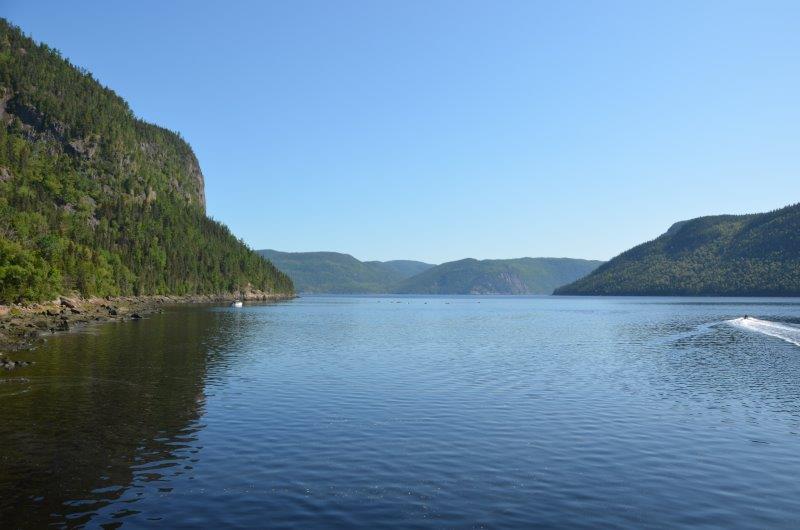
View of the Saguenay Fjord from aboard the the Fjord Saguenay II on the way to L’Anse-Saint-Jean. Photo: Nancy Truman
A short stroll from the docks in a farmhouse on the banks of the Fjord, you’ll find Bistro de L’Anse-Saint-Jean, are restaurant specializing in regional dishes prepared with local produce. La Chasse-Pinte, the onsite microbrewery, creates brews inspired by plants from the Boreal forest, and the menu offers pairing suggestions for every dish. La Peau de Lièvre, a wheat beer flavoured with coriander grains, lavender and chamomile flowers, paired well with the wild salmon tartare with cucumber, chives, puffed rice, and spicy mayonnaise, while the IPA Rousse was an excellent pairing for the fresh pasta served with red venison and seasonal vegetables. Red venison featured tartare served with roasted almonds and cranberries, as well as a burger.
Whale-watching
Tadoussac — perched on a hill at the mouth of the Saguenay where it meets the St. Lawrence River — is ideally situated for this activity. While September and October are the months when these majestic creatures are most actively stocking up on krill for their trip to Caribbean breeding grounds, of the 12 species summering in the Saguenay St-Laurent Marine Park, we found a pair of humpbacks showing off their flukes, a pair of fin whales, a pod of Belugas and a single Minke thanks to the crew on our 2 ½ hour Zodiac tour with Croisières AML. Children must be aged six or older to join the Zodiac tours. There’s also a great Marine Mammal Interpretation Centre where you can hone up on the local whales. Members of the Group for Research and Education on Marine Mammals (GREMM) — a non-profit dedicated to research and marine conservation education — are on hand to answer any questions.
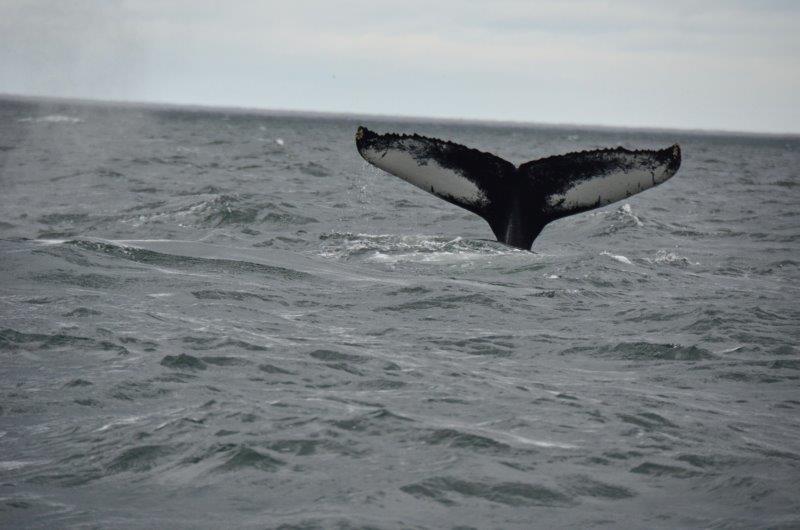
The fluke of a humpback as it dives deep looking for krill in the St. Lawrence River at the edge of the Saguenay St-Laurent Marine Park. Photo: Nancy Truman
For locally inspired cuisine, head to La Galouïne, where native traditions are employed to create surf and turf dishes, with wild mushrooms, Labrador tea, wild blueberries, raspberries, lingonberries, and spruce from the Boreal forest. Onsite smokehouses turn out tender smoked salmon and duck.
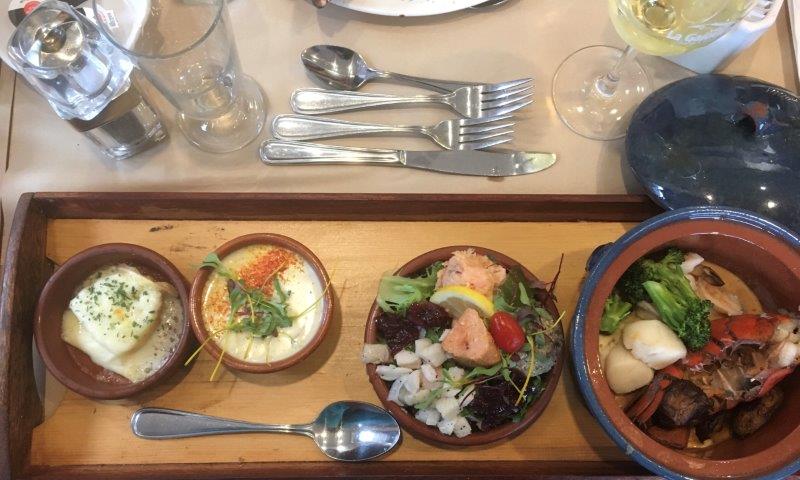
La Galouine’s Croutier du Fjord: a serving board of seafood chowder, smoked salmon, marinated turbot; and a steaming crock of lobster tail, shrimp, scallops, and fish in a lobster bisque. Photo: Nancy Truman
Pick of the crop
It’s easy to spend half a day learning about wild blueberries at Ferme Michel Rivard et Fille, a blueberry and potato farm in Saint-Ambroise. Stay for a lunch of typical homemade fare including the regional take on tourtière, broad bean soup, and blueberry poutine. Save room for the dessert of the day. Along with picking your own blueberries, you can purchase everything from blueberry pies, jam, homemade potato chips, and other terroir products at the farm kiosk. If you’re really into blueberries, 256 km of the region’s more than 700 km of cycling routes, are called the Véloroute des Bleuets, which circles Lac Saint-Jean.
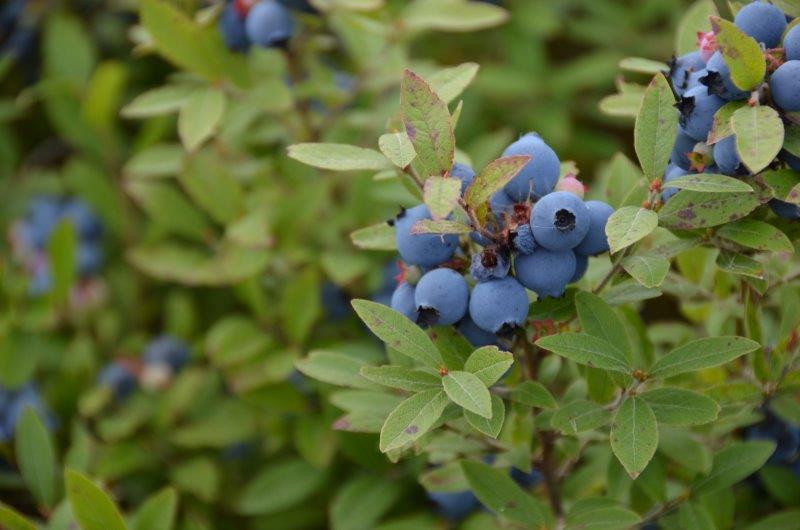
Wild blueberries at Ferme Michel Rivard et Fille near Saint-Ambroise, Que. where you can pick your own, have blueberry poutine or buy some jam. Photo: Nancy Truman
Discovery time
At Musée du Fjord in La Baie, the star attraction is a 53,000-litre saltwater aquarium featuring the inhabitants of the Saguenay Fjord. Children can hold starfish, sea cucumbers, sea urchins, and other species at the touch pool or use a screen to interact with virtual fish to discover their identity. There is also a vivarium with both exotic and native insects from the colourful to the scary. In summer, sign up for a guided walk along the shores of Baie des Ha! Ha! to discover hidden gems. Check ahead because schedules vary according to tides and weather. Click to check out the virtual exhibitions being offered during COVID-19 closures.
While in La Baie, stop by Touverre to watch owner and artisan Guiseppe Benedetto create a glass masterpiece — for us he made a fragile hummingbird — then wander around the shop, which is a bit like a candy store for adults. It helps to understand a bit of French so you can follow his explanations as he works. There is no cost for tours and demonstrations.
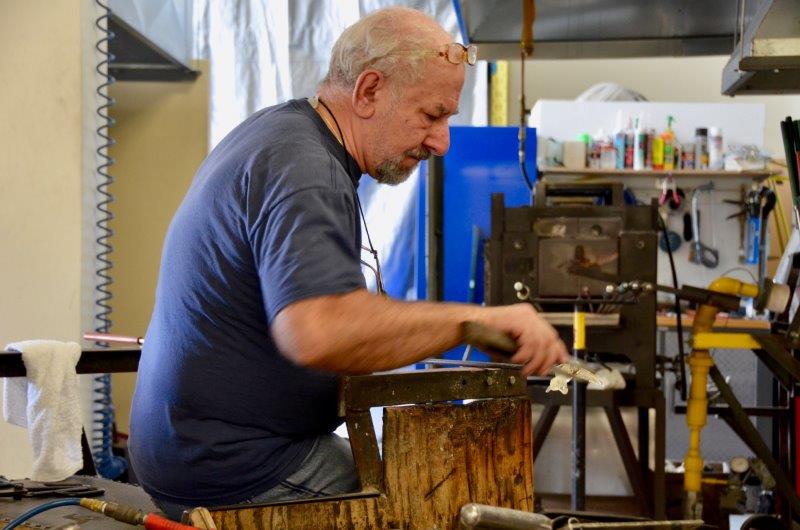
At Touverre in La Baie, Que., artisan Guiseppe Benedetto shapes a hummingbird from glass. Photo: Nancy Truman
Ghost town
Ever wondered what it’s like to spend a night in a ghost town? At the Historical Village of Val Jalbert in Chambord, a once-bustling pulp mill town, you can book a room in the General Store or one of the restored 1920s houses, which had running water, electricity and central heating 25 years before the rest of the province. Today, the warmly decorated, spacious rooms have large washrooms and marble walk-in showers, as well as WiFi access.
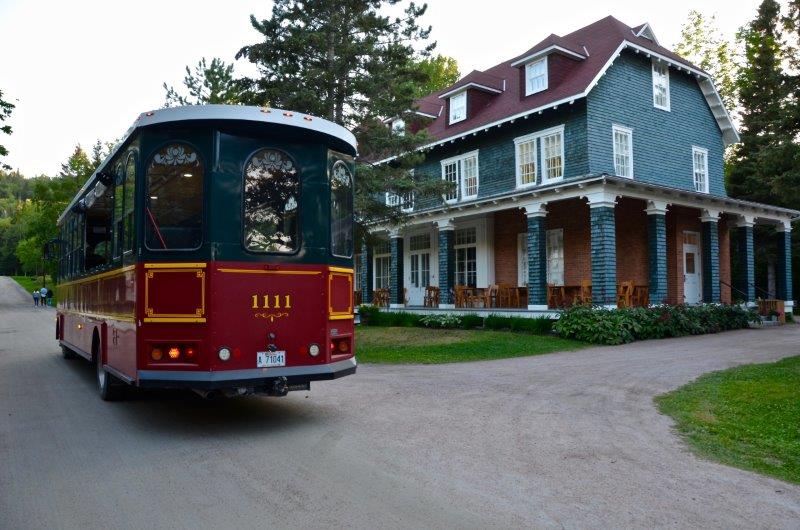
The General Store at the Historical Village of Val Jalbert offers accommodation on the upper floors. Photo: Nancy Truman
On a trolley or walking tour, characters such as the mayor, school-convent nuns, the priest, the superintendent of the mill and the workers give visitors a sense of life in the village in the early 20s. In the pulp mill, walk through the locker room of the workers to get to the mill floor for the multimedia show on the founding of the mill, its heyday and its closing in 1927 and subsequent abandonment of the town. At the heart of the complex is the Ouiatchouan Falls, powering the mill and town as the water plummets 72 metres. At Restaurant du Moulin enjoy a taste of regional specialties and local products. The late August menu included a tourtière in puff pastry with a wild blueberry compote; duck confit with cranberries and scalloped potatoes, and a trio of vanilla, chocolate and orange crème brûlées. Village overnights include a tour, four-course dinner at Restaurant du Moulin and a breakfast buffet. A stay at the campground or cottages offers discounted rates for meals and excursions.
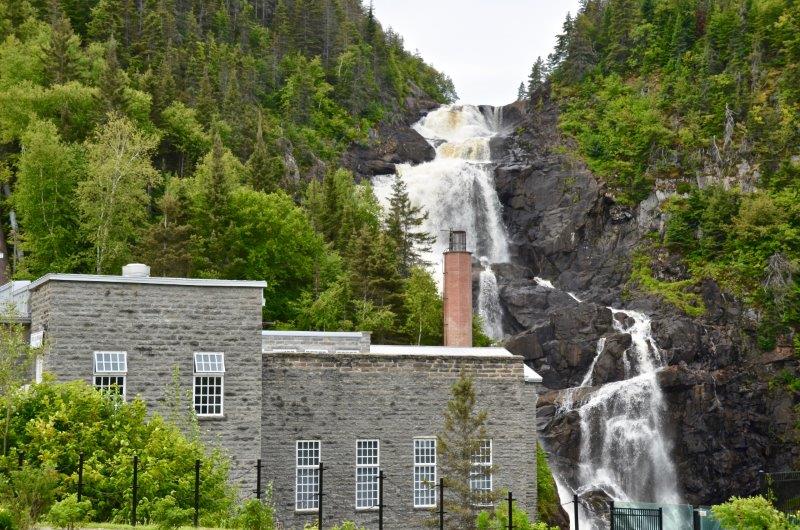
The Ouiatchouan Falls, which drop from a height of 72 metres, powered the pulp mill at Val Jalbert. The deserted town is now a tourist stop. Photo: Nancy Truman
Location, location, location
Along with fantastic views of the Saguenay Fjord, Auberge des 21, a family inn gracing the shore of Baie de Ha! Ha!, specializes in regional cuisine. An ample breakfast buffet featured a large bowl of wild blueberries to enjoy with your cereal or pancakes, and the prix fixe dinner menu (changed seasonally) included scallops from Îles de la Madeleine, local pork and beef and specialities such as a savoury, broad bean soup. The hotel is steps from the Parc Mars, a six-kilometre boardwalk, bicycle path and green space and playground circling the Baie de Ha! Ha!.
Another spot for great views is Hôtel Tadoussac. Situated on a hill above the confluence of the Saguenay and St. Lawrence rivers, many rooms come with sweeping views of the bay and beyond. While it is a full resort experience with an excellent restaurant, an outdoor pool and tennis courts, you’ll likely want to spend most of your time whale-watching, so thankfully the docks, beach, and waterfront are a short walk away, as are shops and restaurants.
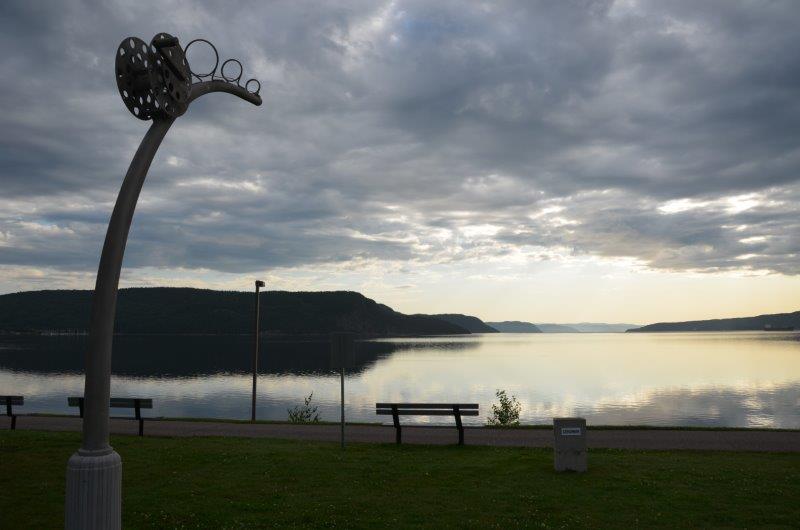
Just steps from Auberge des 21 is Parc Mars, a six-kilometre boardwalk, bicycle path and green space and playground circling the Baie de Ha! Ha! Photo: Nancy Truman
Author: Nancy Truman
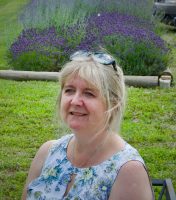 Nancy Truman is a freelance travel writer based in Toronto. While employed as a business editor at National Post, she had the opportunity to turn a passion for travel and photography to writing travel features. Her pieces have appeared in the National Post, Vancouver Province and other Postmedia titles, and in Bold Magazine. She likes to write about food, wine, history and culture, and where ever possible share the stories of people she meets on her journeys.
Nancy Truman is a freelance travel writer based in Toronto. While employed as a business editor at National Post, she had the opportunity to turn a passion for travel and photography to writing travel features. Her pieces have appeared in the National Post, Vancouver Province and other Postmedia titles, and in Bold Magazine. She likes to write about food, wine, history and culture, and where ever possible share the stories of people she meets on her journeys.



